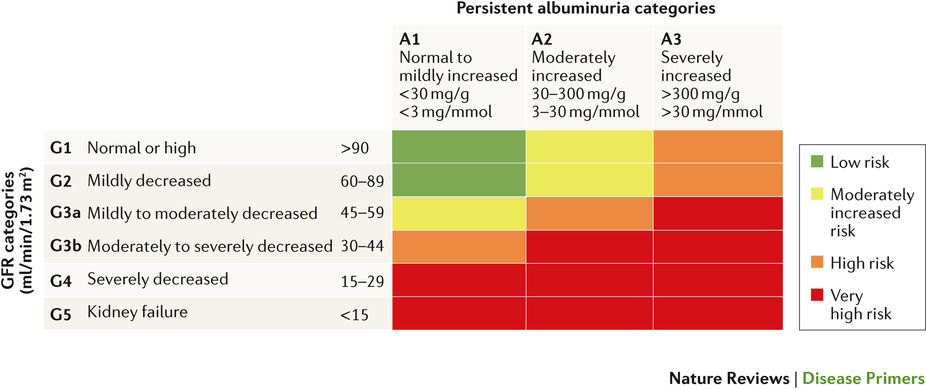慢性腎臓病
Chronic kidney disease
2017年11月23日 Nature Reviews Disease Primers Article number: 17088 (2017) doi: 10.1038/nrdp.2017.88

慢性腎臓病(CKD)は、持続する尿異常、腎形態異常または腎排泄機能障害の存在により定義され、機能性ネフロンの減少が関連すると考えられている。CKD患者の大多数は心血管リスクと死亡リスクが上昇している。末期腎不全に進展した患者でも腎代替療法が利用できない地域が、世界に多くあることが問題になっている。CKDの発症および進行のリスク因子として、出生時の低ネフロン数、加齢によるネフロン数の減少、毒性曝露や2型糖尿病などの原因疾患による急性または慢性腎損傷などが挙げられる。CKD患者の管理では、早期の発見と予防が大切であるが、可能であれば、ネフロン数の減少がさらに進む二次過程への進行とそれに要する治療を回避するために、根本原因の治療も重要視される。血圧管理、レニン-アンジオテンシン系の抑制および疾患特異的介入が治療の基本となる。貧血、代謝性アシドーシス、二次性副甲状腺機能亢進症などのCKD合併症は、心血管健康やQOLに影響を及ぼすため、これらの診断と治療が必要になる。
PrimeView
慢性腎臓病は、機能性ネフロン数の減少につながる多くの要因によって発症すると考えられている。このPrimeViewでは、増加傾向にあるこのよく見られる疾患の主要な特徴について取りまとめる。
本Primerの図解サマリー
Chronic kidney disease (CKD) is defined by persistent urine abnormalities, structural abnormalities or impaired excretory renal function suggestive of a loss of functional nephrons. The majority of patients with CKD are at risk of accelerated cardiovascular disease and death. For those who progress to end-stage renal disease, the limited accessibility to renal replacement therapy is a problem in many parts of the world. Risk factors for the development and progression of CKD include low nephron number at birth, nephron loss due to increasing age and acute or chronic kidney injuries caused by toxic exposures or diseases (for example, obesity and type 2 diabetes mellitus). The management of patients with CKD is focused on early detection or prevention, treatment of the underlying cause (if possible) to curb progression and attention to secondary processes that contribute to ongoing nephron loss. Blood pressure control, inhibition of the renin–angiotensin system and disease-specific interventions are the cornerstones of therapy. CKD complications such as anaemia, metabolic acidosis and secondary hyperparathyroidism affect cardiovascular health and quality of life, and require diagnosis and treatment.

